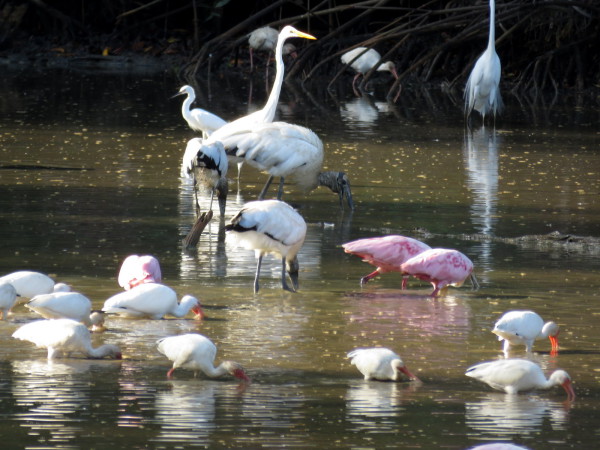In Costa Rica if it’s Flat it’s Probably Wet

There are two main types of wetlands. Marshes of grassy herbaceous plants and swamps with woody trees and shrubs. Most of Costa Rica’s swamps are comprised of mangroves which are described in detail at that link.

Grassy marshes cover much of the north central and eastern lowlands but small patches are common across Costa Rica.
The line between grassy wetlands and mangrove swamp blurs as you move away from the ocean and there are often patchy marshes behind the coastal estuaries especially on the Pacific side.
Costa Rica’s Wetlands
Palo Verde National Park
Leaving the main road and heading towards the Tempisque river in the middle of the huge oval circumscribed by the Pan American Highway north of Limomal and Highway 21 south from Liberia to Nicoya will lead to marshland.
The native grasses, cane and and reeds have been replaced by rice cultivation in much of the region but the center is occupied by Palo Verde national park. Huge expanses of marsh and mangrove swamps are protected along both banks of the Río Tempisque where it splits the mainland from the Nicoya peninsula.
Since our epic first visit by bicycle in 1996 we’ve returned several times to hike and bird watch.
Caño Negro National Wildlife Refuge

Costa Rica’s most visited wetlands are where the Río Frío widens into freshwater marshes at Caño Negro.
Day trips from the resorts and hotels around Arenal volcano board canopied motor-launch wildlife safari boats near the Nicaraguan border at Los Chiles and work upstream on the river between walls of gallery forest full of sloth, monkeys, tamadua and other mammals and mud banks literally crawling with caimen, black river turtles and jesus christ lizards.
Some tours disembark when they reach the wildlife refuge to walk short trails to the edges of the marshes where wading birds hunt in the grass and mud.
Tortuguero National Park
The fresh and brackish water swamps surrounding the canals and lagoons of Tortuguero national park are interspersed with hammocks – protrusions of land with aquatic vegetation that can tolerate immersion – built up around the buttress roots of giant lowland rainforest trees.
The ground looks pretty solid but we don’t recommend beaching your canoe to try to walk around.
Surprise Wetlands

There are often little wetlands where you least expect them. The terrain in the center of Costa Rica is quite steep but occasionally there’s a small valley that traps water to form a marsh or swamp and sometimes even a lake. There are a couple of small wetlands high in the Talamanca mountains that are protected by the OTS as part of the Las Cruces biological station and Wilson Botanical Gardens (the same organization operates the research station at Palo Verde and La Selva).
Along the way to La Fortuna and Arenal volcano from San Ramon in the central valley (route 702) there are another series of little lakes and marshes that you can see from the road high in the Tilarán mountains.
The bowl shape of extinct or inactive volcano craters trap water which usually results in a lake like at Cerro Chato, Arenal’s neighbor. The walls of the crater there are too steep for any marshes to form around the lagoon but sometimes there’s room for shallows, grasses and reeds like at Tenorio, Lago Danta and Lago Barva.
San Vito, the lagos on the way to Arenal, by tenorio lodge
